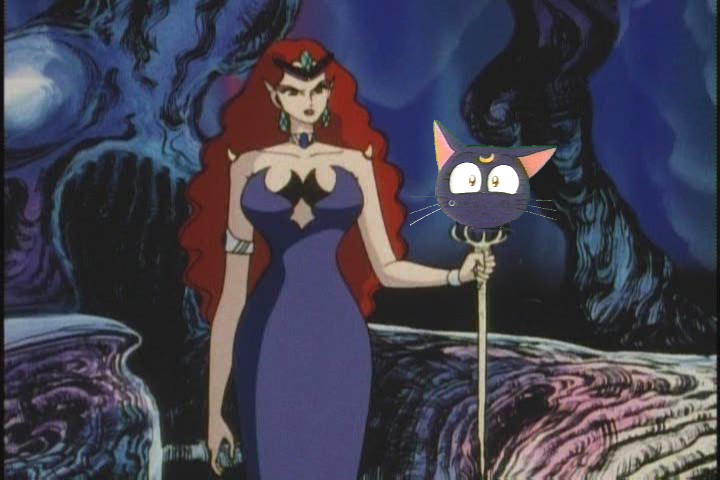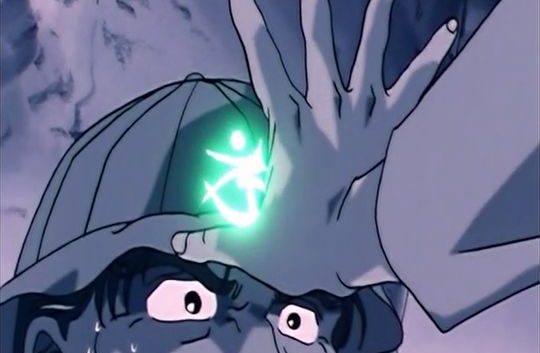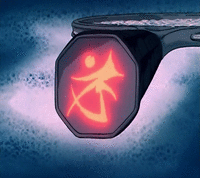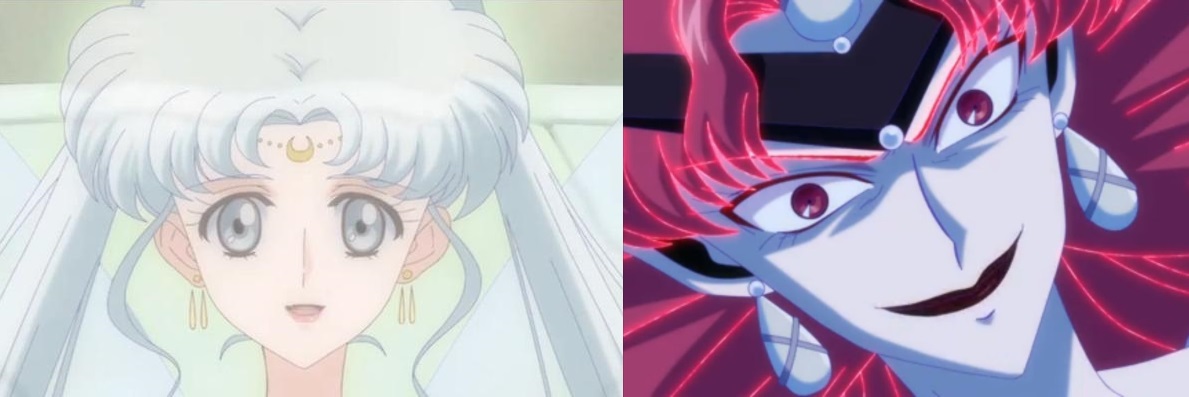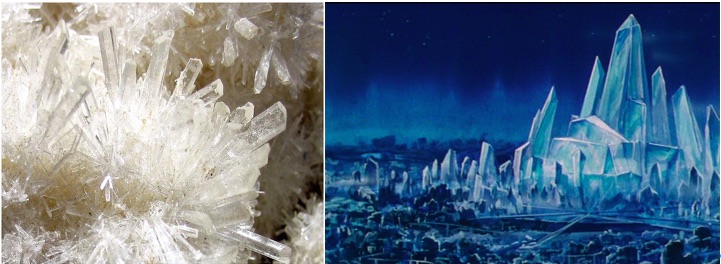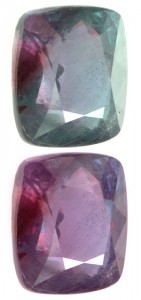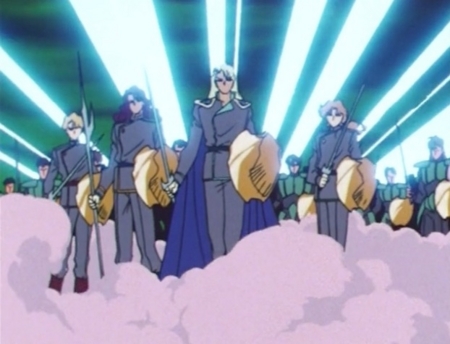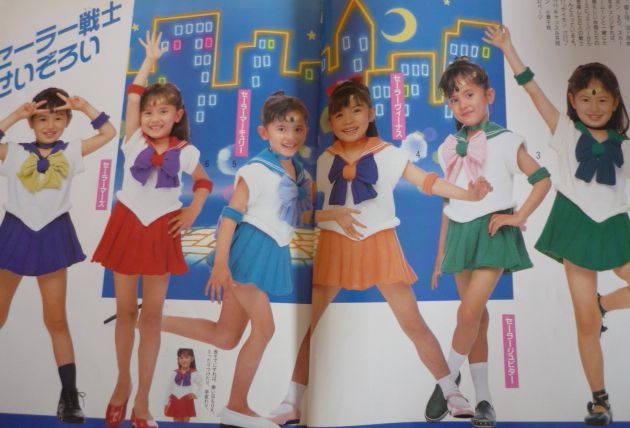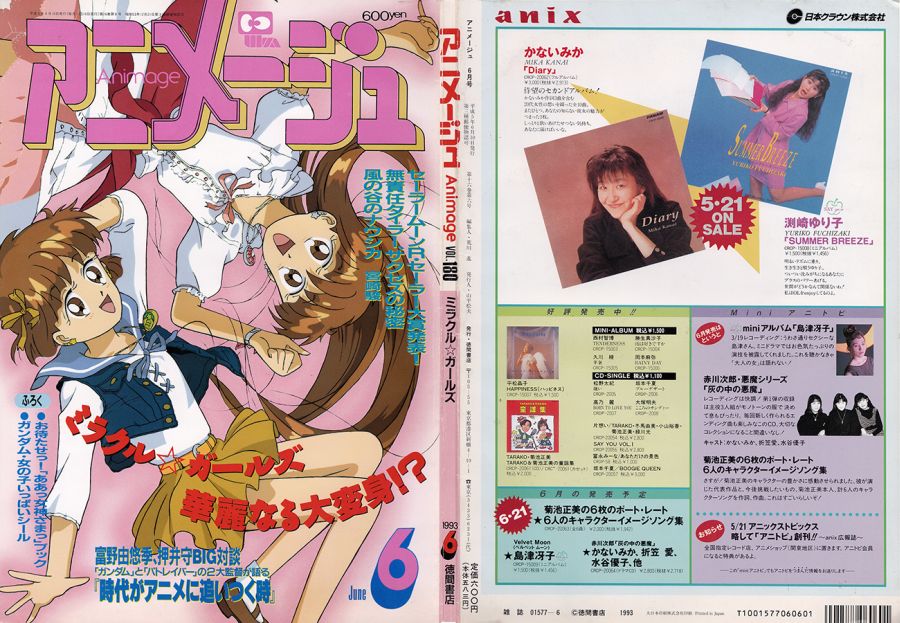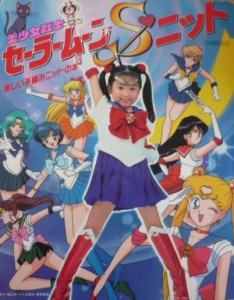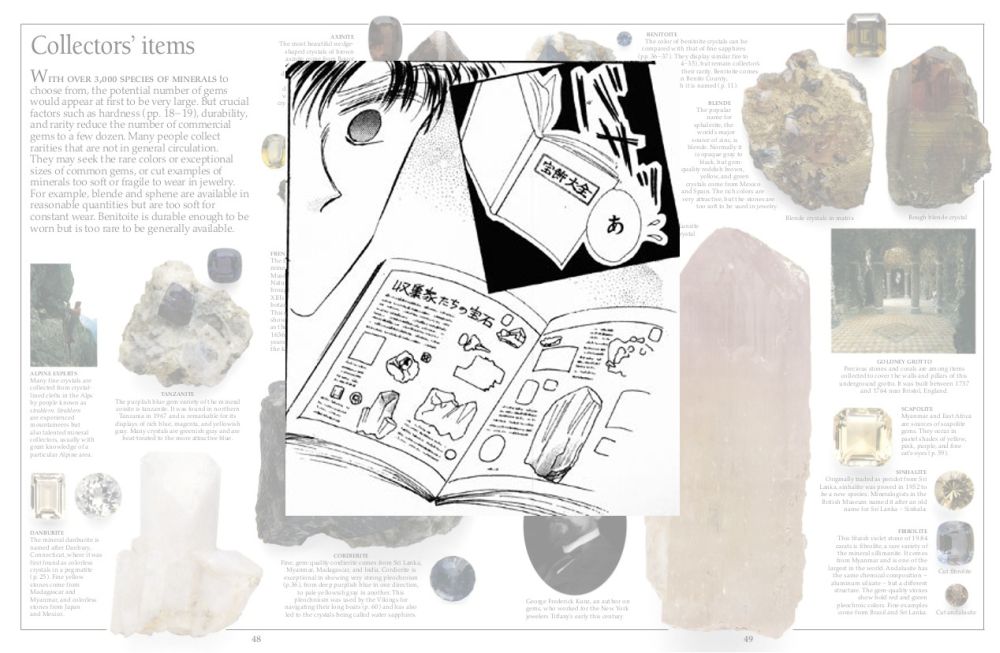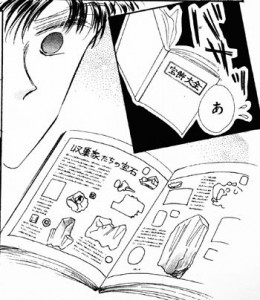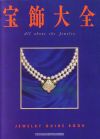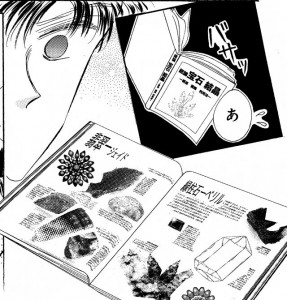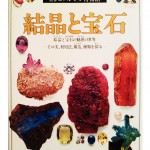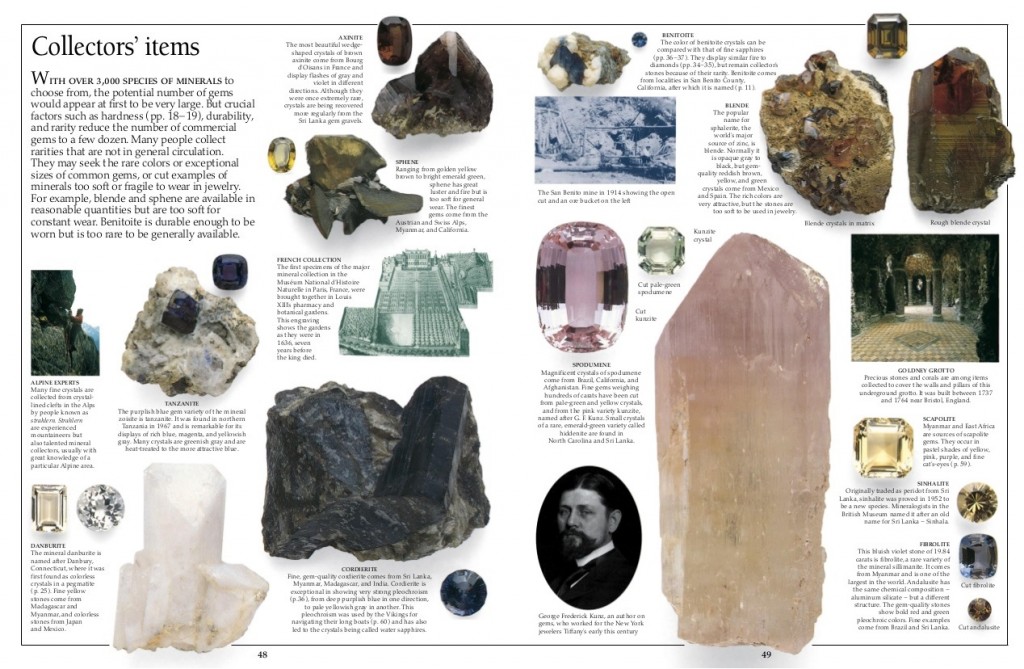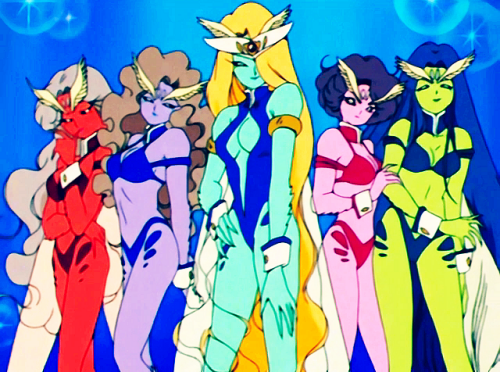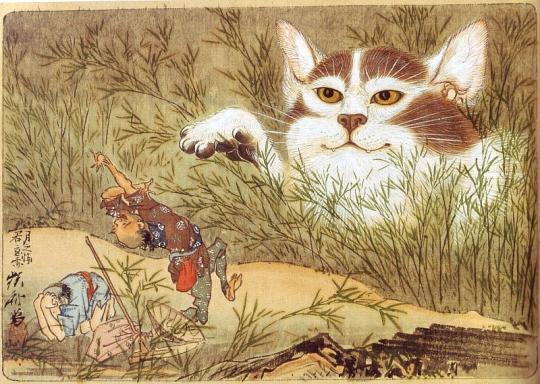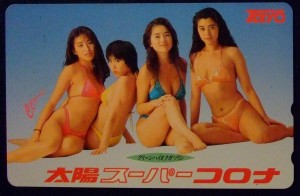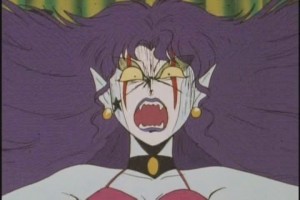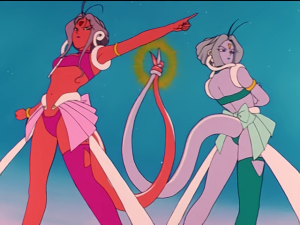One of the more endearing “behind the scene” mysteries to me about the development of the Sailor Moon anime is just why, exactly, did Luna and Queen Beryl share a voice actress. Certainly, Keiko Han was a very talented – and veteran – voice actress who’s been active in the industry since her debut in 1977,1 but that doesn’t explain why the anime would choose to reuse her talent for two major roles. Today, we’ll take a look at one theory to explain this.
Category Archives: Dark Kingdom
What Does Nephrite’s Cursed Symbol Mean?
One of the interesting things about the Classic season of the Sailor Moon anime is that each of the Four Kings of the Dark Kingdom not only had their own unique objectives, but they also had their own youma and their own ways of trying to achieve their goals. While Jadeite may have decided to get energy en masse, for example, Nephrite chose to get energy from a person when they were at their peak. But there’s one thing that I always wondered about many years ago when I watched Nephrite put his mark on his future victims: does that mark actually have any sort of meaning behind it?
The answer to this question is unfortunately, like is often the case when discussing the world of Sailor Moon, both yes and no. While the producers behind the anime were no strangers to adding in obscure hidden references into the background of scenes or playing games with character names, the answer to this question is rather straightforward – if you know where to look for the answer.
Since we see Nephrite use this symbol in multiple episodes when he puts his mark on a possession important to each of his victims, we can pretty definitively state what the proper orientation is (i.e., which way is up and, thus, how it should be interpreted). When you look closely at it, you can see that this symbol is really nothing more than a stylized form of the katakana used to spell out his name in Japanese – more specifically, the ネ (ne) in ネフライト (nefuraito).
But that’s no good reason to get disappointed, not yet at least! First, we need a brief history lesson.1
Hiragana and katakana,2 the two Japanese syllabic alphabets, developed from evolutions – simplifications, really – of kanji, which had been previously used in the form of man’yogana3 wherein kanji was read not for its symbolic meaning, but was used to phonetically spell out Japanese words. This was obviously not ideal for several reasons:
- Very little consistency between authors over which kanji was used to represent which sound (i.e., there are dozens of kanji that can be pronounced ne, so which do you use?)
- Kanji is time-consuming to write and requires more finesse for fine lines
- It was unclear when a kanji should be read for pronunciation and when it should be read for meaning (a proper noun, for example)
The katakana symbol ネ (ne) comes from a simplification of the kanji 祢 (ne),4 more specifically, the left radical of that kanji. When you take a look at how the kanji is simplified when writing in one of the various cursive styles of Japanese calligraphy, you can see the similarities with Nephrite’s mark.
You can see that as the kanji is written in more stylistic manners, the left radical bears a strong resemblance to the mark that Nephrite leaves on all of his victims. It looks like what we have here is a case of the anime producers actually looking back to the past in order to create something new and unique. I told you this wasn’t a complete disappointment!
Now if only someone could explain to me why it would be okay for Nephrite and Naru to date, like the trouble with Usagi and Mamoru in the anime, I think all of my questions would be answered.
What Do Queen Serenity and Queen Metalia Have in Common?
Whether you look at the anime or manga or even the live-action series, despite how important they were to setting up the story behind the Sailor Moon series, Queen Serenity and Queen Metalia both get incredibly minor roles with very little explained about their past or motivations. What’s worse, the Serenity name is passed onto her daughter, Princess Serenity, who then passes it on to her daughter, Princess Usagi Small Lady Serenity. But is there more to these characters than meets the eye? I think so, and that’s what we’re here to look into!
Queen Serenity
Starting with the Serenity line, it’s fortunately pretty easy to track down the meaning and history behind her name, though most of it is probably connected more to Princess Serenity / Usagi more-so than her mother. The most obvious and meaningful connection is the Greek myth of the relationship between Selene, the moon goddess, and the mortal Endymion.1 This gets us partly to the name “Serenity,” though we have one (or possibly two!) other sources of inspiration, all inspired by the Greek connection to the moon.
We all know that Ms. Takeuchi had a strong attachment to astronomy during her developmental years and did a lot of research when making the series, so it should come as no surprise that Usagi’s royal name would be connected to a basin on the Moon, the Mare Serenitatis — or, in English, the Sea of Serenity.2 This is also, incidentally, where the Moon Kingdom was said to be located and where the Sailor Team head in both the anime and manga to consult with the memory of Queen Serenity among the ruins of the Silver Millenium.
So then, what is this third possible reference? Though less of a connection to the late Queen Serenity herself, there seems to be a strong implied connection between Neo-Queen Serenity, Crystal Tokyo, and the mineral known as selenite.3 Selenite is most often clear, though can appear white, pearl, or a variety of other colors depending on impurities. Most notably, it often is found in columns and in tubular designs, not much unlike the designs of the Crystal Tokyo Palace and the Silver Crystal.
Queen Metalia
Like the Four Kings, the connections to geology are a lot more obvious with the Dark Kingdom. There are two notes about the dual monarchy — Queen Beryl and Queen Metalia — that are not obvious at first glance, however. First off, while the most obvious connection with Queen Beryl is to the gemstone beryl.4 However, it’s a little more complicated than that. You see, the Japanese word for queen is 王女 (oujo; queen) though Ms. Takeuchi tends to write the titles (e.g., princess, queen, etc.) out phonetically, such as クイーン (kui-n; queen). However, the titles for both Queen Beryl and Queen Metalia are misspelled in Japanese, and are written as クイン (kuin; no meaning). Why is that?
Well, it’s to give it a double meaning. While it still sounds reasonably close to queen (and is treated canonically that way), it also looks similar to クリソ (kuriso; chryso). So actually, Queen Beryl’s name is more strongly connected to chrysoberyl.5 Just by looking, you can see that this stone much more closely matches the color scheme associated with Queen Beryl, so it’s pretty clear that this is more likely a closer source for her inspiration than normal beryl.
That means that the chryso- connection probably also remains true for Queen Metalia as well, since her name is also written in the same (misspelled) manner. Since here’s no substance known as metalia, we can rule out any special connection there other than it simply being a reference to metal, but with the chryso- prefix attached,6 it modifies the meaning to the metal, gold.
What that ultimately leaves us with is the villain, an evil queen born of hatred from the sun and named in honor of the mineral gold fighting against the Silver Millenium, ruled by the queen of the moon.
Though we never did learn as much about the motivations behind Beryl, Metalia, and the formation of the Dark Kingdom (outside of the musical, of course!) as I would have liked, it’s nice to know that Ms. Takeuchi went through quite a bit of effort to put a little more detail into their names than you’d initially assume. I have to admit, she’s pretty tricky!
How Did Fans React to the Deaths of the Sailor Soldiers?
Though it seems that Ms. Takeuchi was stopped at the last minute by her editor, Fumio Osano, from killing the Sailor Team at the end of the Dark Kingdom arc, their anime counterparts weren’t quite so lucky. For a show which strayed even more into family-friendly territory (which can be seen often with the comical moments between Rei and Usagi that didn’t exist in the manga) and even cut out some of the deaths from the series (such as Jadeite being killed in the manga and frozen in to an eternal slumber, Princess Serenity’s suicide in the manga after the death of Prince Endymion, etc.), it’s a bit odd that they’d go the opposite direction and actually kill off the main cast in the epic climax. So after being lulled into this false sense of security, how did the fans react? And, by extension, their parents?
The information for this article comes from the June 1993 issue of Animage magazine.1
The first, and most widely-publicized, story comes from a midnight radio DJ for Radio Fukushima, Arata Owada.2 As the story goes, he used to would watch Sailor Moon together with his daughter every Saturday and was shocked to watch the Sailor Team fall one by one. He was so upset by this that he actually called up TV Asahi and demanded to know what they planned to do about the characters. Since he often discussed anime on his late-night radio show – and was vocal about his concerns – he eventually caught the attention of Animage, which asked him to do a phone interview.
In the interview, he said that his daughter was so shocked by the ending that she came down for a 40°C (104°F) fever and stayed home from kindergarten for a week. When he finally took her to the doctor, he was told it was autointoxication3 and the doctor asked if she had suffered some sort of trauma or shock recently.
Another – and perhaps more interesting – story comes from a fan-letter section in the same issue of Animage called “Mom’s Too!” In it, a 32 year old mother offered her opinion on the matter. She noted that in real life, people don’t die and then magically come back, so she was opposed to the idea of the Sailor Team so imply being “reset” and then coming back to life as if nothing had happened. She was concerned that her daughter would take away the opposite lesson: that people die and come back, that death isn’t permanent, and may lose out on the importance of life.
Looking around on the internet also gives various anecdotal stories from people about their classmates not coming to school or the author themselves not being able to eat for several days after watching the climax to the first season, so it’s pretty apparent that the impact these episodes had on Sailor Moon fans was huge.
Personally, though, I think it’s a good thing – it really shows that what could be written off as a simple anime really did touch people’s lives, and that the TV Asahi staff did a wonderful job of making these characters real. Isn’t that really the greatest compliment?
What Book Was Mamoru / Endo Reading When He Was Possessed?
I’ve mentioned it many times before, but it always amazes me just how detailed Ms. Takeuchi is in bringing to life the characters (and world) of Sailor Moon. You can really tell that she researches all the names, places, and characters and even puts in a lot of fun finishing touches here and there that leave a lot of fodder for me to answer questions like this! So, just what book did Mamoru – or, more accurately, Endo – forget and leave behind, only for Reika to come and bring back to him?1
At first glance, the title of the book just seemed pretty generic and like something you’d write as a one-off line, akin to the fake movie titles you hear spouted off in movies. The title translates to “Encyclopedia of Jewelry” (宝飾大全; houshoku taizen) and opens up to a page entitled “Collectors’ Stones,” and shows a variety of different stones on it. This seems a bit odd to those of us who are particularly pedantic because the title of the book is specifically about jewelry, while the book itself shows a page on rare (and not-so-rare) stones. So what gives?
Well, after doing a little bit of research, it turns out that there actually was a book by this exact same title, published by Yomiuri Color Mook in February 1991, over a year before this scene appeared in Nakayoshi. However, after taking a look through the index of the book,2 it seems that while Ms. Takeuchi may have used this book as a reference when looking up different stones and their meanings for the series, it probably isn’t the base for the one Mamoru is reading here. The cover, however, does seem similar! But not quite what we’re looking for on the inside.
Around here, I almost gave up and just figured that this was a simple coincidence that the names matched, and maybe Ms. Takeuchi just made the book up. Seems possible, and there might not really be anything deeper to this story. Going back through my notes again, I made one last check of the Sailor Moon Perfect Edition (完全版; kanzenban) to get some higher quality scans and to see if I could get any further details. Wouldn’t you know it, but it turns out this that is yet another one of the scenes where Ms. Takeuchi actually made changes between the original run of the manga and the newer updates!
This time around, the book’s been renamed “General Primer on Gems and Crystals” (総論宝石結晶; soron houseki kesshou) and the inside looks different. Doing a quick search for the title, and bingo! There was a book by a very similar name published back in March 1992 by Relief Systems titled “Crystals and Gems” (結晶と宝石;kesshou to houseki). Now wait a minute, I know I’ve seen this before… and any one who grew up in the early 90s and had to spend time in their school library definitely has too.
After researching this book more, I found out that this is actually a translation of the book titled “Crystal and Gem,” written by Robert F. Symes, and published by DK Children.3 The book has been around since the 1960s and I assume remains relatively unchanged, since a quick look at the index confirms that on pages 48 and 49 (of the English edition, at least) is a section titled “Collectors’ items.” Not much unlike the section found in the first edition of the manga. Even the art style/layout of the English and Japanese book is incredibly similar to the style which Ms. Takeuchi used in the original scene.
In fact, if you take a look at the page and compare it with the image from the manga above, you’ll actually notice that Ms. Takeuchi’s sketch is a near exact copy of these pages! Even more interesting is that page 49 (right page) contains an image in the lower-left corner of Mr. George Kunz, the source of the name for the stone Kunzite. Quite an inside reference!
It’s funny that Ms. Takeuchi actually changed the title of the book in the re-release to be closer to the inspiration, and yet changed the inside of the book to be further away from what the referenced material looks like. It’s not like I don’t understand, though. In the original manga, it was simply a sketch and impossible to get an idea of what the contents of the book were like, while this new version has clearly written text with “Jadeite” and “Beryl” written on it. But it feels a little less nuanced, and more like she’s throwing you a softball.
However, I’m honestly impressed that Ms. Takeuchi went this far to put a reference to Kunzite in here, in a small sketch of a book in one tiny panel. Great job!
How Did the Youma of the Dark Kingdom Get Their Names? (Part 2)
Now we move onto the latter half of the first season of Sailor Moon and onto the youma serving under Zoisite. What’s interesting about this is that though we were generally granted our usual “one monster of the day” to meet the quota, for the most part these youma didn’t actually serve under Zoisite, but rather belonged to the Seven Great Youma, which had existed since the time of the Silver Millennium and were simply uncovered by Zoisite or the Sailor Team. Also rarely noted is that Queen Beryl herself also has youma which report directly to her, though to be honest, the structure of the Dark Kingdom is a bit hard to follow in the first place. Anyway, as we did in Part 1, let’s take a look at how the youma of the Dark Kingdom got their names!
Zoisite
- Yasha: This is the Japanese word for Yaksha,1 a natural spirit appearing in Hindu, Jain, and Buddhist texts. The meaning behind the face mask and the monster form is in reference to the female and male yakshas, which were portrayed respectively as beautiful with round faces and attractive figures, or as fearsome warriors.
- You may recognize this name as being similar to the character Inuyasha, from the series with the same name. This is the same yasha being referenced.
- Grape, Suzuran, and Housenka: Often referred to by Western fans as the “Plant Sisters,” though in the Japanese version they’ve been given no name other than the “Three Youma Girls.” Their names are clever plays off of flowers, but by using different kanji also spell out the names of their attacks, though unfortunately I can’t find any sort of deeper meaning behind Grape. As for the other two:
- Suzuran when written as 鈴蘭 (suzuran) means “lily of the valley,” but by using a clever word play could be written as 鈴乱 (suzuran) which means something akin to “bell disturbance” (harmonic disorder?). Her attack name is 鈴乱れの音 (suzumidare no oto), meaning something like “Sonic Disrupting Screech!”
- Housenka when written as 鳳仙花 (housenka) means a garden balsam, but the first part of her name can also be written as 砲戦 (housen), which is an artillery barrage. This is likely in reference to the fireballs she shoots.
- Akan: This is a mix of the Japanese word あかん (akan) meaning bad, wrong, or something you shouldn’t be doing.2 Also, あか (aka) can also mean red, which explains the color.
- As an interesting bit of trivia, this is the only time which any of the Four Kings other than Kunzite turns a normal human into a youma.
Seven Great Youma
- Gesen: A direct reference to the Japanese word for arcade — ゲームセンター (game center), often abbreviated as ゲーセン (gesen).
- Boxy: A Japanese pun which plays on both “boxer,” and the Japanese word for priest, 牧師 (bokushi).
- Bunbo: Seeing as this youma was reincarnated as Ryo Urawa, one of the few characters to nearly match Ami in intelligence, and he’s themed after stationary supplies, his name — based on the Japanese word 文房具 (bunbougu; stationary supplies) — makes sense!
- Binah: This is likely in reference to Binah,3 one of the ten Sephirah,4 which are considered to be the revelations of the Creator’s Will.
- Rikoukeidar: The name is a play on the Japanese term 理工系 (rikoukei) for a person who is considered more logical (rather than artistic) or what we’d consider a science type. Makes sense considering the type of school Reika went to!
- Jiji: This name is a double pun, based on the slang used to refer to an old man じじ (jiji; derived from おじさん, ojisan) and 獅子 (shishi), the basis for two 狛犬 (komainu) which appear outside Shinto shrines.5
- Bakene: A play off of 化け猫 (bakeneko),6 one of the youkai, or ghosts/spirits, of Japanese legends.
Kunzite
- Mitsuami: A direct reference to the Japanese word 三つ編み (mitsuami) meaning hair braided from three strands.
- Shakoukai: A double pun playing on the term 社交界 (shakoukai) meaning social circle and 貝 (kai) meaning shellfish.
- Blizzar: With all the hard work they put into names, I’m kinda disappointed that they went with a simple reference to blizzards here. I guess to Japanese speakers the reference isn’t so obvious, though?
- Zoyrin Geller / Doyrin Geller: The Japanese pronunciation of this name isn’t even known among Japanese fans, much less among the Western audiences. One possible explanation is that the name is in reference to Solingen (pronounced with a Z in German and in Japanese), which is known as the City of Blades,7 which may be in reference to the ice skates.
- As a bit of trivia, Janelyn (the female member of the pair) is a reference to Janet Lynn,8 an Olympic American figure skater.
- Papillon: From the French word for butterfly.
- Oniwabandana: A reference to the 御庭番 (oniwaban),9 secret agents serving under the Tokugawa government as spies and security guards. The second half of the name is also a play on bandana.
Queen Beryl
- Thetis: A clear reference to the sea nymph of Greek mythology of the same name.10
- One interesting thing about Thetis is that she’s one of the few youma who actually shows much personality and even interacts within the Dark Kingdom. She also was one of the strongest to appear until the Seven Great Youma.
- DD Girls: Unfortunately, none of the individual team members have their own name, but rather are just known by their color. However, the group’s name is a reference to the Japanese all-girl pop group C.C. Girls,11 and mixed in with the reference to the D-Point, where the final battle took place.
And there you have it, an in-depth look into the names of all of the youma as they appeared in the first season of Sailor Moon! I gotta admit it was a bit exhausting, but I’m happy to see that the producers of this series went so far out of their way to put so many hidden meanings in these one-shot enemies. Who’d have known!
[(1-20-2015) Edited to add: Thanks for the catch on Boxy and 牧師 goes to Sailormoon Canada on Twitter!]
How Did the Youma of the Dark Kingdom Get Their Names? (Part 1)
One of the many recurring themes that we keep touching on over and over in the world of Sailor Moon is the significance of names, and the minions of the Dark Kingdom are no different. The majority of their names are either directly related to the specific youma’s power, appearance, or the main character of the day in the episode, but quite a few of them actually have a surprising backstory behind them! So, without further ado, let’s take a look at the names of the youma as they appeared in the first season, separated by who they served under.
Jadeite
- Morga: This is a hard one since there’s really no direct links in Japanese or English to her name, but judging by her appearance, the ga part of her name is likely in reference to 餓 (ga), meaning “to starve.” She also remarks in the manga that Naru’s mother is likely starving to death and locked up.
- Speaking of the manga, she’s one of the few “monsters of the day” who appeared in both the manga and the anime throughout the entirety of the Sailor Moon series, though she didn’t have a name in the manga.
- Balm: A clever play off of the word “palm,” in reference to palm reading and, more generally, fortune telling.
- Frau: Many people claim this is a play off of the Japanese word 振る (furu; to dump), but that doesn’t make sense in this context. Most likely it’s a play off of “flower,” in reference to the broaches given away that sap listerners’ energy.
- Iguara: A pretty clear reference to an iguana, due to the pet shop which was opened and the design of the enemy.
- As an aside, he cute animals that smell all-so-nice in this episode, chanela, are an obvious reference to Chanel, the brand of perfume.
- Kyurene: Spelled the same in Japanese as Cyrene/Kyrene of Greek mythology, a strong and aggressive female hunter.1
- Derella: Derived from a shortening of Cinderella.
- Garoben: A play off of the Japanese term ガリ勉 (gariben) meaning to be fanatic about studying,2 and probably in reference to all the students and how hard they were studying (and as a result, having their energy taken from them).
- Ramua: An anagram of the Japanese word for “alarm” (as in, alarm clock). A – Ra – Mu = Ra – Mu – A
- Kigaan: A play off of the Japanese word 祈願 (kigan) meaning prayer,3 which is typically offered up at a Shinto shrine.
- Murid: “Dream” written backwards in Japanese. Do – Ri – Mu = Mu – Ri – Do
Nephrite
- Tesuni: An anagram of the Japanese word for “tennis.” Te – Ni – Su = Te – Su – Ni
- Petasos: This is likely in reference to the ancient Greek hat known by the same name, petasos, in reference to the hat which Nephrite uses to syphon energy.4
- Widow: Pretty obviously in reference to the black widow spider.
- Kyameran: Could be interpreted either as: (i) An “n” added to the Japanese word for camera, or (ii) a contraction of “camera” and “man” to become Cameran.
- Jumeau: In reference to the Bisque dolls5 which were popular in the late 1800s. A French company, Jumeau,6 was one of the most famous manufacturers.
- Regulus: Direct reference to the star, Regulus.
- Castor and Pollux: In reference to the stars and the characters by the same name in Roman mythology.7
- As an interesting aside, it’s said that the models for two of the staff at the animation studio appearing in this episode, Hiromi Matsuno and Kazuko Tadashita, are none other than Hiromi Matsushita and Kazuko Tadano (husband and wife character designers and animators working at Studio Live on producing Sailor Moon episodes at the time)8
This takes us all the way through the first half of the original season of Sailor Moon, but it’s already getting pretty long, so I think we’ll need to hold off for part two until the next time around. Next up, we’ll be taking a look at the youma which service under Zoisite and Kunzite, along with the Seven Great Youma themselves and those that served directly under Queen Beryl. There’s plenty of more trivia to be found!
